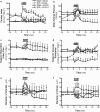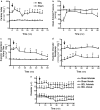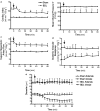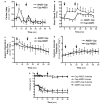Anandamide mediates hyperdynamic circulation in cirrhotic rats via CB(1) and VR(1) receptors - PubMed (original) (raw)
Anandamide mediates hyperdynamic circulation in cirrhotic rats via CB(1) and VR(1) receptors
L Moezi et al. Br J Pharmacol. 2006 Dec.
Abstract
Background and purpose: Hyperdynamic circulation and mesenteric hyperaemia are found in cirrhosis. To delineate the role of endocannabinoids in these changes, we examined the cardiovascular effects of anandamide, AM251 (CB(1) antagonist), AM630 (CB(2) antagonist) and capsazepine (VR1 antagonist), in a rat model of cirrhosis.
Experimental approach: Cirrhosis was induced by bile duct ligation. Controls underwent sham operation. Four weeks later, diameters of mesenteric arteriole and venule (intravital microscopy), arterial pressure, cardiac output, systemic vascular resistance and superior mesenteric artery (SMA) flow were measured after anandamide, AM251 (with or without anandamide), AM630 and capsazepine administration. CB(1), CB(2) and VR1 receptor expression in SMA was assessed by western blot and RT-PCR.
Key results: Anandamide increased mesenteric vessel diameter and flow, and cardiac output in cirrhotic rats, but did not affect controls. Anandamide induced a triphasic arterial pressure response in controls, but this pattern differed markedly in cirrhotic rats. Pre-administration of AM251 blocked the effects of anandamide. AM251 (without anandamide) increased arterial pressure and systemic vascular resistance, constricted mesenteric arterioles, decreased SMA flow and changed cardiac output in a time-dependent fashion in cirrhotic rats. Capsazepine decreased cardiac output and mesenteric arteriolar diameter and flow, and increased systemic vascular resistance in cirrhotic rats, but lacked effect in controls. Expression of CB(1) and VR1 receptor proteins were increased in cirrhotic rats. AM630 did not affect any cardiovascular parameter in either group.
Conclusions and implications: These data suggest that endocannabinoids contribute to hyperdynamic circulation and mesenteric hyperaemia in cirrhosis, via CB(1)- and VR1-mediated mechanisms.
Figures
Figure 1
Effect of anandamide (3 mg kg−1) (ANM) infusion with or without preadministration of AM251 (3 mg kg−1) on cardiac index (a), MAP (b), SMA flow (c), systemic vascular resistance (d), mesenteric arteriole diameter (e) and mesenteric venule diameter (f) in cirrhotic or sham-control rats. Values are the mean±s.e.m. of 6–8 rats per group. *P<0.05 for comparison of BDL-placebo group with the corresponding sham-placebo groups. #P<0.05 for comparison of the BDL-placebo group with the corresponding BDL+AM251 groups.
Figure 2
Effect of AM251 (3 mg kg−1) administration on cardiac index (a), MAP (b), SMA flow (c), systemic vascular resistance (d) and mesenteric vessel diameter (e) in cirrhotic or sham-control rats. Values are the mean±s.e.m. of 6–8 rats per group. Arrows indicate time of administration of AM251. *P<0.05 for comparison of BDL group with the corresponding sham group.
Figure 3
Effect of capsazepine (3 mg kg−1) administration on cardiac index (a), MAP (b), SMA flow (c), systemic vascular resistance (d) and mesenteric vessel diameter (e) in cirrhotic or sham-control rats. Values are the mean±s.e.m. of 6–8 rats per group. Arrows indicate time of administration of capsazepine. *P<0.05 for comparison of BDL group with the corresponding sham group.
Figure 4
Effects of combination sequential AM251 (3 mg kg−1) and capsazepine (3 mg kg−1) on cardiac index (a), MAP (b), SMA flow (c), systemic vascular resistance (d) and mesenteric vessel diameters (e) in cirrhotic rats. Values are the mean±s.e.m. of 4–6 rats per group. Arrows indicate time of administration of either AM251 or capsazepine. *P<0.05 significantly different from baseline value in each group.
Figure 5
Western blot protein expression of CB1 (a), CB2 (b) and VR1 (c) receptor protein in SMA of sham (lanes 1–3) and BDL (lanes 4–6) rats. Lane 7 is the positive control (CB1, cerebellum; CB2, spleen and VR1, cerebrum). BDL rats show significantly increased CB1 and VR1 protein expression compared to sham-controls. CB2 expression is not significantly different between the two groups.
Figure 6
RT–PCR of CB1 (a), CB2 (b) and VR1 (c) receptor mRNA in SMA of sham (lanes 1–3) and BDL (lanes 4–6) rats. Lane 7 is the positive control (CB1, cerebellum; CB2, spleen; and VR1, cerebrum). BDL rats show significantly increased CB1 mRNA expression, but unchanged CB2 and VR1 mRNA expression compared to sham-controls.
Similar articles
- Role of Ca2+-dependent potassium channels in in vitro anandamide-mediated mesenteric vasorelaxation in rats with biliary cirrhosis.
Yang YY, Lin HC, Huang YT, Lee TY, Hou MC, Wang YW, Lee FY, Lee SD. Yang YY, et al. Liver Int. 2007 Oct;27(8):1045-55. doi: 10.1111/j.1478-3231.2007.01551.x. Liver Int. 2007. PMID: 17845532 - Role of endocannabinoids in the pathogenesis of cirrhotic cardiomyopathy in bile duct-ligated rats.
Gaskari SA, Liu H, Moezi L, Li Y, Baik SK, Lee SS. Gaskari SA, et al. Br J Pharmacol. 2005 Oct;146(3):315-23. doi: 10.1038/sj.bjp.0706331. Br J Pharmacol. 2005. PMID: 16025138 Free PMC article. - Anandamide elicits an acute release of nitric oxide through endothelial TRPV1 receptor activation in the rat arterial mesenteric bed.
Poblete IM, Orliac ML, Briones R, Adler-Graschinsky E, Huidobro-Toro JP. Poblete IM, et al. J Physiol. 2005 Oct 15;568(Pt 2):539-51. doi: 10.1113/jphysiol.2005.094292. Epub 2005 Aug 4. J Physiol. 2005. PMID: 16081483 Free PMC article. - Triphasic blood pressure responses to cannabinoids: do we understand the mechanism?
Malinowska B, Baranowska-Kuczko M, Schlicker E. Malinowska B, et al. Br J Pharmacol. 2012 Apr;165(7):2073-88. doi: 10.1111/j.1476-5381.2011.01747.x. Br J Pharmacol. 2012. PMID: 22022923 Free PMC article. Review. - Endocannabinoids and liver disease. V. endocannabinoids as mediators of vascular and cardiac abnormalities in cirrhosis.
Moezi L, Gaskari SA, Lee SS. Moezi L, et al. Am J Physiol Gastrointest Liver Physiol. 2008 Oct;295(4):G649-53. doi: 10.1152/ajpgi.90352.2008. Epub 2008 Aug 14. Am J Physiol Gastrointest Liver Physiol. 2008. PMID: 18703639 Review.
Cited by
- Hepatic targeting of the centrally active cannabinoid 1 receptor (CB1R) blocker rimonabant via PLGA nanoparticles for treating fatty liver disease and diabetes.
Hirsch S, Hinden L, Naim MB, Baraghithy S, Permyakova A, Azar S, Nasser T, Portnoy E, Agbaria M, Nemirovski A, Golomb G, Tam J. Hirsch S, et al. J Control Release. 2023 Jan;353:254-269. doi: 10.1016/j.jconrel.2022.11.040. Epub 2022 Nov 30. J Control Release. 2023. PMID: 36442615 Free PMC article. - Interplay of cardiovascular mediators, oxidative stress and inflammation in liver disease and its complications.
Matyas C, Haskó G, Liaudet L, Trojnar E, Pacher P. Matyas C, et al. Nat Rev Cardiol. 2021 Feb;18(2):117-135. doi: 10.1038/s41569-020-0433-5. Epub 2020 Sep 30. Nat Rev Cardiol. 2021. PMID: 32999450 Review. - Antiallodynic effect of PhAR-DBH-Me involves cannabinoid and TRPV1 receptors.
Quiñonez-Bastidas GN, Palomino-Hernández O, López-Ortíz M, Rocha-González HI, González-Anduaga GM, Regla I, Navarrete A. Quiñonez-Bastidas GN, et al. Pharmacol Res Perspect. 2020 Oct;8(5):e00663. doi: 10.1002/prp2.663. Pharmacol Res Perspect. 2020. PMID: 32965798 Free PMC article. - Impact of liver damage on blood-borne variables and pulmonary hemodynamic responses to hypoxia and hyperoxia in anesthetized rats.
Sepehrinezhad A, Dehghanian A, Rafati A, Ketabchi F. Sepehrinezhad A, et al. BMC Cardiovasc Disord. 2020 Jan 13;20(1):13. doi: 10.1186/s12872-019-01297-z. BMC Cardiovasc Disord. 2020. PMID: 31931715 Free PMC article. - Endocannabinoid System in Hepatic Glucose Metabolism, Fatty Liver Disease, and Cirrhosis.
Bazwinsky-Wutschke I, Zipprich A, Dehghani F. Bazwinsky-Wutschke I, et al. Int J Mol Sci. 2019 May 22;20(10):2516. doi: 10.3390/ijms20102516. Int J Mol Sci. 2019. PMID: 31121839 Free PMC article. Review.
References
- Batkai S, Jarai Z, Wagner JA, Goparaju SK, Varga K, Liu J, et al. Endocannabinoids acting at vascular CB1 receptors mediate the vasodilated state in advanced liver cirrhosis. Nat Med. 2001;7:827–832. - PubMed
- Benham CD, Davis JB, Randall AD. Vanilloid and TRP channels: a family of lipid-gated cation channels. Neuropharmacology. 2002;42:873–888. - PubMed
- Bonz A, Laser M, Kullmer S, Kniesch S, Babin-Ebell J, Popp V, et al. Cannabinoids acting on CB1 receptors decrease contractile performance in human atrial muscle. J Cardiovac Pharmacol. 2003;41:657–664. - PubMed
Publication types
MeSH terms
Substances
LinkOut - more resources
Full Text Sources





